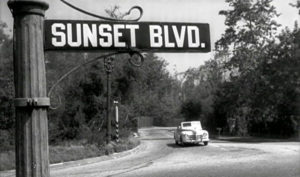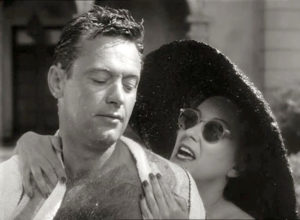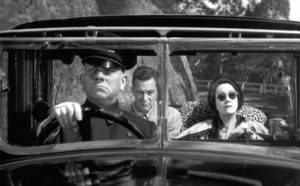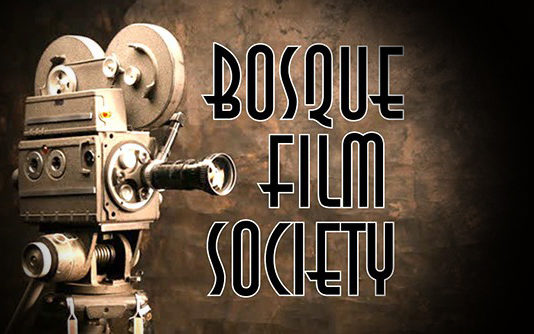“We didn’t need dialogue. We had faces!” SUNSET BOULEVARD kicks off BFS Film Appreciation Series
By BRYAN DAVIS
Bosque Film Society Founding Historian & Board Member
The 1950 Billy Wilder film noir classic, “Sunset Boulevard,” served to debut the 2022 Bosque Film Society Film Appreciation Night series at the historic Cliftex Theater on February 8. Often called “the definitive Hollywood horror story,” some 31 members attended the screening, many seeing the 72-year-old movie for the first time. I was pleased to introduce the movie prior to the film, which was selected by BFS members at the December 14 Christmas Gathering.

Prior to 1900, Hollywood was known best for its orange groves. It wasn’t until 1911 that the first movie studio was located in Hollywood on, you guessed it, Sunset Boulevard. But by 1915, many of the major motion-picture companies had relocated to Hollywood from the East coast, and Sunset Boulevard became synonymous with all that glitters as the Movie Capital of the World. Over the past 110 years, there have been a lot of films made about Hollywood, but “Sunset Boulevard” remains the gold standard for movies about movies.
“Sunset Boulevard” ranks high on nearly all “best of” movie lists in multiple categories. It’s typically classified as film noir, the French term for “dark film,” a genre most popular during the 1940s and 50s. It’s always been a favorite of mine since I first saw it as a kid. I kind of doubt it played at The Cliftex, as it was a bit daring in 1950.
In 2020, IMDb ranked Billy Wilder’s Ten Best Films. The list included most of his classic Oscar winners, but “Sunset Boulevard” was crowned best of the best. “In his most acclaimed film,” IMDb wrote, “Wilder tackles the seedy side of Hollywood. Sunset Boulevard is a haunting, complex, and brilliant film. In fact, it has often been called one of the greatest movies ever made. It is Wilder’s masterpiece.”
When the American Film Institute named their List of 100 Best Movies, Wilder managed to have four listed. At #80 is “The Apartment” (1960) which won the best picture Oscar and Wilder’s second best director Oscar. At #29 is “Double Indemnity” (1944), which established Wilder as one of Hollywood’s preeminent directors. At #22 is 1959’s “Some Like It Hot,” which ranks #1 on the AFI’s List of 100 Funniest Films. And at #16 is “Sunset Boulevard,” which ranked as high as #12 in the original AFI Top 100 Films in 1997. The AFI also has a category called 100 Best Movie Quotes, and two from Sunset Boulevard made the list, both from the character of Norma Desmond. At #24, “I am big! It’s the pictures that got small.” And at #7 “All right, Mr. DeMille, I’m ready for my close-up.”

The Director Billy Wilder
Billy Wilder, the brilliant writer and director behind “Sunset Boulevard,” is regarded as one of the most successful directors in Hollywood history. In addition to the four of his films listed in AFI’s 100 Best Movies of all time, ten of his works are preserved in the United States National Film Registry of the Library of Congress as being “culturally, historically or aesthetically significant.”
Wilder was born into a Polish/Jewish family in present-day Austria in 1906. He first moved to Berlin as an adult, where newspaper writing led him to screenwriting. Hitler’s rise to power forced Wilder’s move to Paris, and then to Hollywood in 1933. His mother, step-father and grandmother all died during the Holocaust. Wilder’s first work in Hollywood as a screenwriter included the films “Ninotchka,” in 1939, and “Ball of Fire” and “Hold Back the Dawn,” both 1941. Many believe the story of the struggling screenwriter of “Sunset Boulevard” is a thinly disguised portrait of Wilder’s early struggles in Hollywood. Writing quickly evolved into directing as well, and he excelled in every genre of film.
Wilder’s initial success gradually gave him the power in Hollywood to eventually evolved into directing his own stories giving him more creative control of his pictures, and ultimately the audience a better movie experience. In his long career, Wilder was nominated for an astounding 21 Academy Awards; eight for directing and 13 for writing. Only Martin Scorsese and William Wyler had more nominations as a director.
Wilder won two directing Oscars, his first for 1945’s best picture drama about alcoholism, “The Lost Weekend,” and his second for 1960’s “The Apartment.” He won three Oscars for his screenplays, “Double Indemnity,” “Sunset Boulevard,” and “The Apartment.” Charles Brackett was Wilder’s longtime writing partner, collaborating on more than a dozen films, including “Sunset Boulevard,” sharing that Oscar. Wilder had hoped to direct “Schindler’s List” as his final film as a tribute to family. But it never happened and Steven Spielberg took over the project which was released in 1993 and won Oscars for both best film and best director for Spielberg. Billy Wilder died in 2002 at the age of 95.

Gloria Swanson Plays Norma Desmond
Gloria Swanson was as big a star as Hollywood had seen during the early years of film. She began her career as an extra in 1914 and was already headlining films while still in her teens. She appeared in some of the biggest movies of the silent era, helping to make Paramount Pictures, which is but one example of life imitating art with “Sunset Boulevard.” She was directed seven times by D.W. Griffith. Her fame rivaled contemporaries like Lillian Gish and Mary Pickford, but her image not nearly as wholesome. She had six husbands and a public affair with Joseph Kennedy, the father of the future president. She was one of the first women to begin her own production company, and was a nominee for the very first best actress Academy Award in 1928 for the silent film, “Sadie Thompson,” which she produced. She won another Oscar nomination the following year for “The Trespasser,” her first talking picture. But her career in film was all but over by 1940 and she turned to radio, stage work, and television.
Norma Desmond, considered one of the best characters ever written for the screen, was suspected of being a composite of several aging queens of the silent era, some known for not only being reclusive, but emotionally unstable as well. Norma would prove to be a hard role to cast. But, sometimes casting miraculously works out as it should. Audiences are surely the richer that Shirley Temple didn’t play Dorothy in “The Wizard of Oz,” and that Doris Day turned down the role of Mrs. Robinson in “The Graduate.” And that Mae West, Mary Pickford, Norma Shearer and Greta Garbo all turned down the role of Norma Desmond. In Norma, Gloria Swanson found the part of a lifetime and something for which she could well relate… a faded star of the silent pictures waiting for a comeback. But Swanson was insulted that Wilder and producers required a screen test. After all, Gloria Swanson had pretty much made Paramount Pictures, where she was their number one star for six years. The director and Swanson friend George Cukor told her if she had to do 100 screen tests it would be the role she’d be forever be known for.
Filming commenced in 1949 and when completed actress Barbara Stanwyck saw the film at a private screening at Paramount along with other notable Hollywood movers and shakers. Stanwyck is said to have knelt and kissed the hem of Swanson’s gown. Others were not so kind. Louis B. Mayer, head of MGM, approached Wilder before the crowd of celebrities and said, “You have disgraced the industry that made and fed you! You should be tarred and feathered and run out of Hollywood!” But Swanson’s performance was universally praised. She was nominated for her third Oscar, won the Golden Globe award, and many film historians still regard her performance as one of the greatest on film.

William Holden and Other Casting
William Holden had struggled in B films for more than a decade after his screen debut in 1939. He only landed the part of screenwriter Joe Gillis after Montgomery Clift was cast and broke his contract two weeks before filming began. Wilder had hoped to sign Broadway’s Marlon Brando for his movie debut, but he also said no, as did Fred McMurray and Gene Kelly. The role of Gigolo Joe made Holden a household name and he became the top male box office star of the 1950s and worked for Wilder in two more films during the decade, “Sabrina” and “Stalag 17,” for which he won the best actor Academy Award in 1954.
Nancy Olson, who plays William Holden’s love interest Betty, received an Oscar nomination for the film at age 21 as supporting actress. She and Holden were paired together in four movies, but her career in Hollywood was short-lived. And today at 93, Olson is one of the oldest living Oscar nominees and the last surviving cast member of “Sunset Boulevard.”
Erich von Stroheim, who portrays Norma’s butler Max in the film (and so much more), is a fascinating man whose real life in many ways mirrored the character he plays in “Sunset Boulevard.” Von Stroheim hated the role, but it brought him as Oscar nomination as best supporting actor. Along with Cecil B. DeMille and D.W. Griffith, he is considered one of the greatest directors of silent films. And, like Wilder, he was born in Austria and would become one of the most visionary directors of the silent era. His 1924 film “Greed,” is considered one of the most important films ever made. After clashes with Hollywood studio bosses over budgets and workers’ rights issues, Von Stroheim was essentially banned for life as a director. Interestingly, he directed Gloria Swanson in the 1928 film, “Queen Kelly,” but was fired over conflicts with the actress. The scenes of young Norma Desmond shown in “Sunset Boulevard” are outtakes from Von Stroheim’s film. He took the role for the money, but today the film is what Stroheim is primarily remembered for.

Other fascinating actors featured in the film are director Cecil B. DeMille, playing himself during the filming of his 1949 movie, “Sampson and Delilah,” on the Paramount lot. Gossip columnist Hedda Hopper also has a cameo as herself as well. Norma Desmond’s card playing friends, called “the waxworks,” are played by silent film legends and Swanson friends Buster Keaton, Anna Q. Nilsson, and H.B. Warner. Keaton rivaled Charlie Chaplin in popularity during the silent era, and Warner was a huge star as well. He played Jesus Christ in DeMille’s “King of Kings” in 1927, then went on to star in many Frank Capra’s classics, perhaps best known as the drunken druggist in “It’s A Wonderful Life.” A young Jack Webb is also featured, years before he would gain fame on television for “Dragnet.”
The film was a box office success and received critical acclaim and 11 Oscar nominations, including best picture, director, actor and actress, supporting actor and actress, cinematography and editing. Its three Oscars wins came for art direction and set decoration, screenplay, and musical score. But its reputation has only grown in the 72 years since it was first released.
Film Appreciation Series & Arthouse Film Series
Next up in line for the BFS Film Appreciation Series will be the 1954 Alfred Hitchcock thriller Rear Window, starring James Stewart and Grace Kelly. Hitchcock won his fourth of five best director Oscar nominations for this classic, which the American Film Institute has ranked #48 on its list of 100 Greatest Films. Rear Window will be shown at 7 p.m. at the Cliftex on Tuesday, April 12.
Other films scheduled for the FILM APPRECIATION NIGHT in 2022 include: Butch Cassidy & Sundance Kid (1969), June 13; All That Jazz (1979) on August 9; Out of Africa (1989) on October 11; and White Christmas (1954) as the BFS Christmas Party on December 13. All BFS members are invited to attend.
Filling in the monthly gap of film presentations, the Bosque Film Society voted to add the ARTHOUSE FILM SERIES to its movie presentation schedule at the historic Cliftex Theatre in 2022.
From thoughtful dramas to unconventional romances, these independent treasures from a variety of countries, primarily independent films, offer something deeper than the usual Hollywood movie. Aside from the classically-defined Arthouse films, the Bosque Film Society selections can include ground-breaking films of its time, underappreciated masterpieces and forgotten seldom-seen classics.
Arthouse films take aim at a niche market rather than a mass market audience, intended to be a serious, artistic work, often experimental. Not designed for mass appeal, Arthouse films are made primarily for aesthetic reasons rather than commercial profit, and contain unconventional or highly symbolic content.
Upcoming ARTHOUSE FILM NIGHT presentations will include: March 8 — Modern Times (1936); May 10 — Citizen Kane (1941); July 12 — The Seventh Seal (1957); Sept. 13 — Dr. Strangelove (1964); Nov. 8 – Day for Night (1973).
